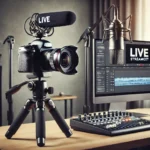Introduction
Live streaming has become a dominant form of content delivery, whether for events, gaming, webinars, or online meetings. For creators and producers, ensuring smooth audio & video optimization is essential to provide a high-quality viewing experience. One common issue that can detract from this experience is audio sync problems—when the sound doesn’t quite match the video. Fortunately, setting up an audio delay can resolve this issue easily.
In this guide, we’ll walk you through how to set up an audio delay for live streaming effectively, improving both quality and viewer satisfaction.
The Problem with Audio-Video Sync Delays
Even slight issues with audio-video synchronization can result in negative feedback from viewers. Delays typically occur because audio is processed faster than video. Video capture and encoding take more time due to higher data sizes and rendering processes.
Common causes of audio-video desynchronization include:
- High video latency from encoding hardware or software
- Inconsistent frame rates in multi-source streams
- Equipment compatibility issues
- Network lag during broadcasting
Viewers may perceive poor sync as unprofessional or annoying. For streamers, these problems can cause drops in engagement and hamper channel growth. That’s why proper audio & video optimization, including setting up delays, is critical.
How to Set Up Audio Delay for Live Streaming
Thankfully, tackling sync issues doesn’t require extensive technical knowledge. Using streaming software like OBS Studio, Streamlabs, or hardware encoders, you can insert a custom audio delay.
Step 1: Identify the Delay Duration
Start by identifying the delay between your audio and video. Record a short test clip and check for misalignment. Tools like VLC Media Player or editing software (e.g., Adobe Premiere) can help you frame-by-frame diagnose where the audio lags or leads video.
Once determined, note the delay time in milliseconds (ms). Common settings usually range between 100ms to 300ms.
Step 2: Adjust Delay in Streaming Software
OBS Studio
OBS is one of the most widely used tools for live broadcasting. Here’s how to apply audio delays in OBS:
- Navigate to Edit > Advanced Audio Properties
- Locate your microphone audio input
- In the Sync Offset column, enter the delay value in milliseconds
- Test stream and adjust if necessary
Streamlabs
Streamlabs OBS offers a similar interface:
- Go to the Audio Mixer
- Click gear icon > Advanced Audio Settings
- Adjust Sync Offset next to microphone input
- Save and test your live stream
Hardware-Based Streaming
If you’re using hardware encoders or mixers (like Elgato, XSplit, or Blackmagic devices), the audio delay option is often in the settings menu or via companion software. Check device manuals or online resources to locate audio delay configuration.
Step 3: Sync Multi-Device Sources
If using multiple input devices (e.g., DSLR cameras, external mics, game consoles), some sources may introduce unique delays. Apply separate sync offsets to individual audio and video sources within the software.
Step 4: Monitor and Re-Test
After setting delays, conduct a test stream to verify results. Watch for:
- Lip sync accuracy
- Background noise alignment
- Clarity during high-motion scenes
Make iterative adjustments until you achieve flawless syncing.
Tools for Audio & Video Optimization
For enhanced results, consider tools dedicated to audio and video quality:
- VoiceMeeter Banana: A virtual audio mixer for more refined control
- OBS Plugins: Use plugins like OBS-VirtualCam or Tuna for real-time preview
- Elgato Sound Capture: Offers easy management of game, chat, and mic audio
These tools help identify latency discrepancies and allow real-time delay tuning.
Benefits of Adding Audio Delay in Live Streams
Putting the right sync strategy in place brings major improvements:
1. Professional Quality Streams
With delayed audio correction, broadcasts look and sound polished. It reflects positively on the brand or personal content channel.
2. Reduced Viewer Complaints
Viewers are less likely to abandon streams or leave negative feedback when audio matches video correctly.
3. Higher Engagement and Retention
Synced audio contributes to viewer satisfaction, resulting in longer watch time and increased engagement metrics.
4. Better Multi-Camera Collaboration
If you’re using a multi-camera setup, synchronized audio ensures seamless transitions between different angles.
5. Improved Post-Production Efficiency
Synchronized raw footage simplifies video editing and prevents time-consuming manual audio adjustments.
Advanced Tips for Better Audio & Video Optimization
- Use Quality Hardware: Pairing high-quality microphones and capture cards reduces out-of-sync risks.
- Record Locally: Simultaneously record local versions of your stream using OBS or third-party software for easier post-stream fixes.
- Stream at Stable Bitrates: Ensuring stable upload speeds reduces network-induced delay mismatches.
- Calibrate Before Each Session: Cameras, mics, and systems can behave differently on different days—test syncing before going live.
Conclusion
Setting up an audio delay for live streaming may seem minor, but its impact on audio & video optimization is huge. It ensures your broadcast feels professional and enjoyable, keeping your audience tuned in to your message.
Don’t let desynchronized playback ruin your content. Take the time to precisely adjust your audio delay settings, monitor performance, and refine your setup regularly.
Ready to level up your live streams? Make audio & video syncing part of your pre-stream checklist and deliver content that looks—and sounds—spot on.
Explore related resources on optimizing streaming software settings, improving audio quality, and more in our Live Streaming Guide.
